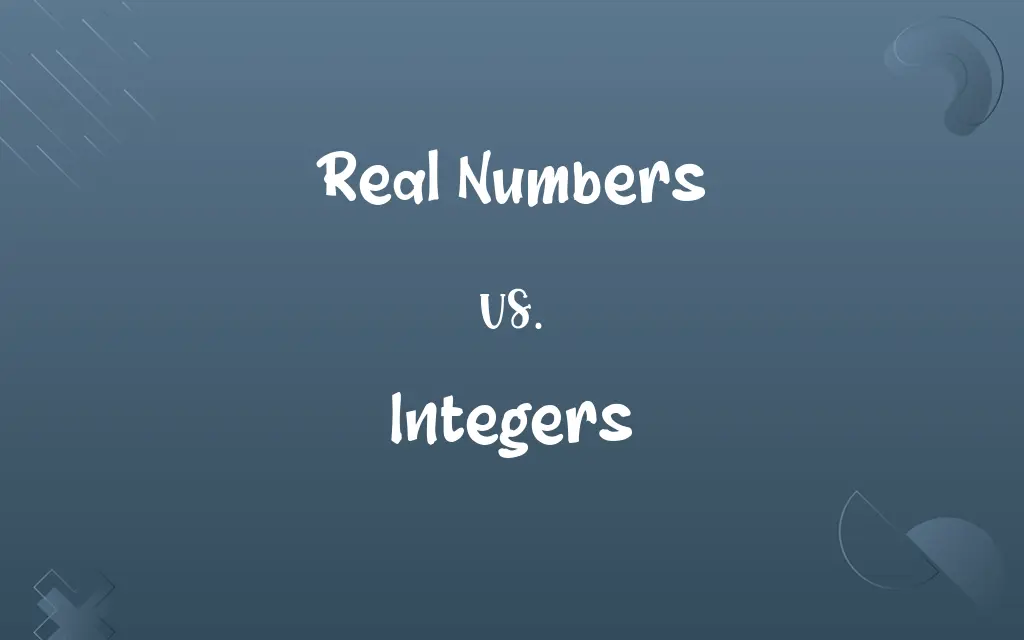Real Numbers vs. Integers: Know the Difference

By Shumaila Saeed || Published on February 2, 2024
Real numbers include all rational and irrational numbers, whereas integers are whole numbers that can be positive, negative, or zero.

Key Differences
Real numbers encompass all the numbers that can be found on the number line, including both rational (like 1/2, 3, -5) and irrational numbers (like √2, π). Integers are a subset of real numbers, specifically whole numbers which include positive numbers, negative numbers, and zero, but not fractions or decimals.
Shumaila Saeed
Feb 02, 2024
Every integer is a real number, but not every real number is an integer. Real numbers include both rational numbers (which can be expressed as a fraction of two integers) and irrational numbers (which cannot be expressed as a simple fraction). Integers, on the other hand, are always rational since they can be represented as a fraction with a denominator of one.
Shumaila Saeed
Feb 02, 2024
On a number line, real numbers cover every possible point, with no gaps in between, representing both rational and irrational numbers. Integers are evenly spaced points on the number line, occurring at regular intervals with no fractions or decimals in between.
Shumaila Saeed
Feb 02, 2024
Real numbers can be added, subtracted, multiplied, and divided (except by zero), with the results often being non-integers. Integers behave similarly under addition, subtraction, and multiplication, but division of two integers may not result in an integer.
Shumaila Saeed
Feb 02, 2024
Real numbers are used in a variety of mathematical contexts, especially where precision is required, like in calculus and scientific measurements. Integers are used in everyday contexts like counting objects, in programming, and where fractional values are not applicable.
Shumaila Saeed
Feb 02, 2024
ADVERTISEMENT
Comparison Chart
Definition
All rational and irrational numbers
Whole numbers (positive, negative, zero)
Shumaila Saeed
Feb 02, 2024
Include Fractions/Decimals
Yes, includes fractions and decimals
No, no fractions or decimals
Shumaila Saeed
Feb 02, 2024
Irrational Numbers
Includes irrational numbers
Does not include irrational numbers
Shumaila Saeed
Feb 02, 2024
Number Line Coverage
Covers every point on the number line
Only at specific points (whole numbers)
Shumaila Saeed
Feb 02, 2024
ADVERTISEMENT
Real Numbers and Integers Definitions
Real Numbers
Real numbers can be positive, negative, or zero, and include decimals and fractions.
The temperature -3.5°C is represented by a real number.
Shumaila Saeed
Jan 17, 2024
Integers
Integers are used in situations where only whole numbers make sense.
You can't have half a person, so population counts are integers.
Shumaila Saeed
Jan 17, 2024
Real Numbers
Real numbers include all numbers on the number line, both rational and irrational.
The number π (pi) is a real number used to calculate the circumference of a circle.
Shumaila Saeed
Jan 17, 2024
Integers
Integers are whole numbers that can be positive, negative, or zero.
The number of students in a class, say 25, is an integer.
Shumaila Saeed
Jan 17, 2024
Real Numbers
Real numbers are used in calculations that require precise measurements.
In engineering, real numbers are essential for accurate dimensions and calculations.
Shumaila Saeed
Jan 17, 2024
ADVERTISEMENT
Integers
The set of integers includes the natural numbers, their negatives, and zero.
The thermometer showed -10 degrees, which is an integer.
Shumaila Saeed
Jan 17, 2024
Real Numbers
Real numbers are fundamental in mathematics, representing continuous values.
The square root of 2, an irrational number, is an example of a real number.
Shumaila Saeed
Jan 17, 2024
Integers
Integers do not include fractions or decimals and are evenly spaced on the number line.
Counting steps, like 1, 2, 3, ..., involves integers.
Shumaila Saeed
Jan 17, 2024
Real Numbers
The set of real numbers encompasses both terminating and non-terminating decimals.
The number 0.333... (repeating) is a real number.
Shumaila Saeed
Jan 17, 2024
Integers
Integers are often used in programming for counting and indexing.
Array indexes in computer programming are typically integers.
Shumaila Saeed
Jan 17, 2024
Integers
A member of the set of positive whole numbers {1, 2, 3, ... }, negative whole numbers {-1, -2, -3, ... }, and zero {0}.
Shumaila Saeed
Jan 17, 2024
Integers
(mathematics) The set of all integers; the set {... -3, -2, -1, 0, 1, 2, 3 ...}.
Shumaila Saeed
Jan 17, 2024
Repeatedly Asked Queries
What is the difference between real numbers and whole numbers?
Real numbers include both whole numbers and fractions, while whole numbers are a subset of real numbers.
Shumaila Saeed
Feb 02, 2024
What are real numbers?
Real numbers are a set of numbers that includes all rational and irrational numbers, covering a wide range of values on the number line.
Shumaila Saeed
Feb 02, 2024
Are integers real numbers?
Yes, integers, which are whole numbers and their negative counterparts, are a subset of real numbers.
Shumaila Saeed
Feb 02, 2024
Can real numbers be negative fractions?
Yes, negative fractions, such as -3/4 or -1/2, are real numbers.
Shumaila Saeed
Feb 02, 2024
Do real numbers include non-terminating and non-repeating decimals?
Yes, real numbers encompass both terminating decimals (like 0.25) and non-terminating, non-repeating decimals (like π or √2).
Shumaila Saeed
Feb 02, 2024
Are negative integers smaller than positive integers?
Yes, negative integers are considered smaller in magnitude than positive integers.
Shumaila Saeed
Feb 02, 2024
Are negative numbers considered real numbers?
Yes, negative numbers, along with positive numbers and zero, are part of the real number set.
Shumaila Saeed
Feb 02, 2024
Do real numbers include complex numbers?
No, complex numbers, which involve imaginary units (e.g., √(-1)), are a separate set from real numbers.
Shumaila Saeed
Feb 02, 2024
What are integers?
Integers are whole numbers, including both positive numbers (e.g., 1, 2, 3) and their negative counterparts (e.g., -1, -2, -3), along with zero (0).
Shumaila Saeed
Feb 02, 2024
Can zero be considered a positive integer?
Zero is not considered a positive integer but is a distinct integer, often referred to as a "neutral" integer.
Shumaila Saeed
Feb 02, 2024
Are integers countable or uncountable?
Integers are countable because they can be listed systematically (e.g., 0, 1, -1, 2, -2, ...).
Shumaila Saeed
Feb 02, 2024
What are consecutive integers?
Consecutive integers are a sequence of integers where each number is exactly one unit larger (or smaller) than the previous one.
Shumaila Saeed
Feb 02, 2024
Can real numbers be expressed as fractions?
Yes, many real numbers can be represented as fractions or ratios of integers, such as 1/2 or 3/4.
Shumaila Saeed
Feb 02, 2024
Are square roots of non-perfect squares real numbers?
Yes, square roots of non-perfect squares, like √2 or √5, are real numbers and considered irrational.
Shumaila Saeed
Feb 02, 2024
Are real numbers countable or uncountable?
Real numbers are uncountable, meaning they cannot be listed in a systematic way, unlike integers or rational numbers.
Shumaila Saeed
Feb 02, 2024
Do integers include fractions like 1/2 or 3/4?
No, integers do not include fractions; they are only whole numbers, both positive and negative.
Shumaila Saeed
Feb 02, 2024
Can integers be used for counting objects?
Yes, integers are commonly used for counting, as they represent whole quantities without fractions or decimals.
Shumaila Saeed
Feb 02, 2024
Are fractions considered integers?
No, fractions are not integers; they are a different subset of numbers that include rational numbers.
Shumaila Saeed
Feb 02, 2024
Do integers include decimal fractions?
No, integers are whole numbers without decimal or fractional parts.
Shumaila Saeed
Feb 02, 2024
Are integers considered a subset of real numbers?
Yes, integers are a subset of real numbers, as they are included within the larger set of real numbers that encompasses all rational and irrational numbers.
Shumaila Saeed
Feb 02, 2024
Share this page
Link for your blog / website
HTML
Link to share via messenger
About Author
Written by
Shumaila SaeedShumaila Saeed, an expert content creator with 6 years of experience, specializes in distilling complex topics into easily digestible comparisons, shining a light on the nuances that both inform and educate readers with clarity and accuracy.







































































